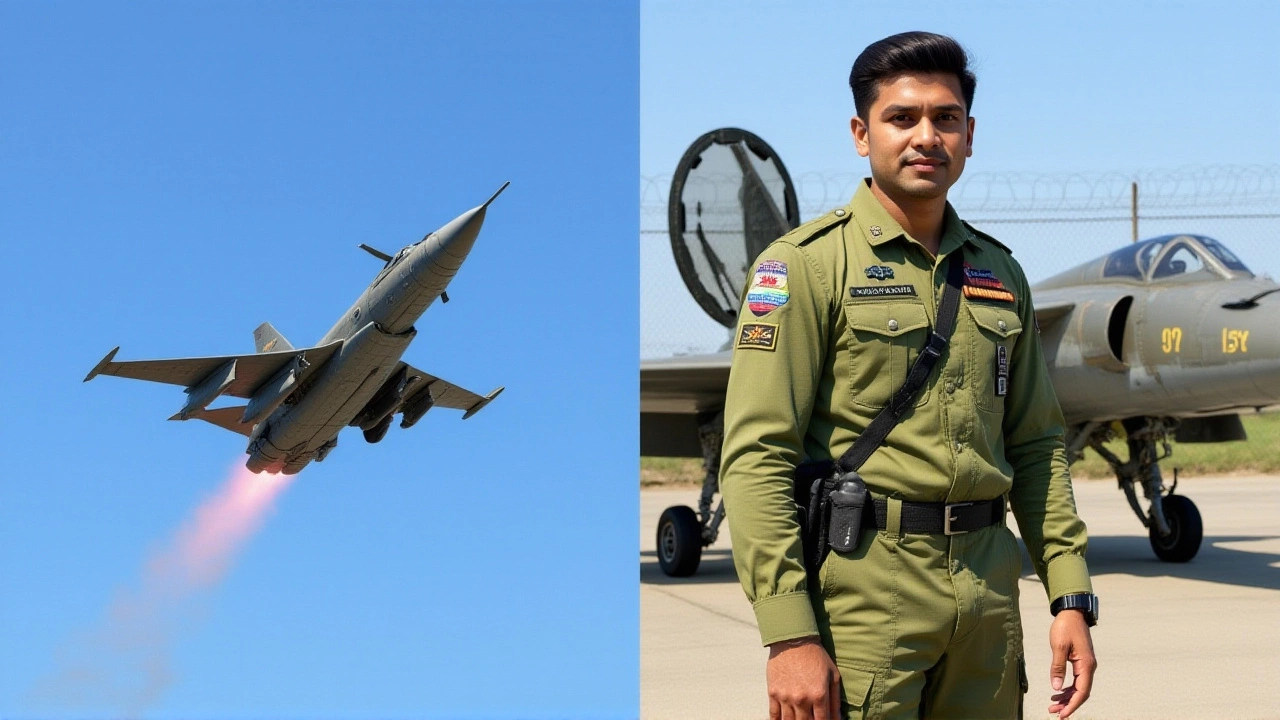Wing Commander Namansh Syal, 34, gave his life not just in service—but in sacrifice. The Indian Air Force pilot died on the Dubai Air Show 2025Al Maktoum International Airport on November 21, 2025, when the Hindustan Aeronautics Limited (HAL)-built Tejas Light Combat Aircraft he was flying plummeted during a low-altitude aerobatic routine. Witnesses saw the single-engine fighter, renowned for its agility and reliability, suddenly lose height at around 3:40 pm IST, nosedive into the desert sands, and erupt in flames. Video footage captured a brief, desperate flash—a parachute-like deployment at the 49-second mark—too late, too low. He didn’t eject to save himself. He steered the burning jet away from crowds.
A Pilot Who Chose Others Over Himself
The Indian Air Force confirmed what many onlookers suspected: Syal, a seasoned instructor with over 1,200 flight hours, deliberately manipulated the aircraft’s trajectory to avoid populated zones near the airfield. His final act, a split-second decision made under unimaginable pressure, likely saved dozens of lives. The Indian Air Force called it "an act of extraordinary professionalism." The Southern Air Command echoed it on X: "His sacrifice will forever inspire."
According to aviation analysts, the crash may have been triggered by a compressor stall—a sudden disruption in airflow inside the engine—caused by sustained high-G turns during the maneuver. Aditya Khullar, a defense analyst, noted on X that the Tejas, despite its flawless safety record over 300,000 flight hours, had never before experienced such a failure during a public display. The aircraft’s fly-by-wire system, designed to prevent pilot-induced oscillations, may have been overwhelmed by the rapid, repeated inputs needed to recover from a low-altitude stall.
Life in the Sky, Roots in the Soil
Syal hailed from Patialkar village, a quiet hamlet in Kangra district, Himachal Pradesh. He was the son of retired Naib Subedar Jagan Nath, a 71-year-old Army Medical Corps veteran who spent his evenings scrolling through YouTube clips of his son’s aerial stunts. When the news came, he was still watching. His wife, Wing Commander Afsana, also an IAF pilot, was in Kolkata for training. Their six-year-old daughter was with relatives in Sulur, Tamil Nadu, where Syal had been stationed with an operational squadron.
At the Sulur Air Force Station, his body arrived on November 22. By Sunday, November 23, the coffin draped in the Tricolor reached Patialkar. Hundreds lined the roads. Youth Services and Sports Minister Yadvinder Goma, HRTC Vice Chairman Ajay Verma, and senior military officers stood in silent tribute. The village school closed. Elders wept. Children held flags. He was cremated with full military honors—21-gun salute, bugle call, folded flag presented to his widow.
A Legacy of Excellence
Syal wasn’t just a pilot—he was a role model. At Sainik School, he was house captain. At the National Defence Academy, he rose to Academy Cadet Adjutant. As an IAF instructor, he trained over 40 new pilots in the last three years. His uncle, Madan Lal, recalled: "He topped every class. Never missed a day. Always had a book in hand, even after long flights."
His death sent shockwaves across India. Himachal Pradesh Chief Minister Sukhvinder Singh Sukhu called him "a brave son taken far too soon." Firstpost reported emotional scenes at his village, with residents describing him as "the boy who flew higher than anyone ever dreamed." The Indian Air Force released a statement: "His skill, dedication, and dignified persona earned him immense respect. We stand with his family in this hour of profound grief."

What Happens Now?
A court of inquiry has been formally constituted to determine the cause. Investigators are reviewing telemetry data, cockpit voice recordings, and the aircraft’s maintenance logs. One critical question: Did the Tejas’s engine experience a compressor stall due to the aerobatic profile? Or was there a systems malfunction? The crash occurred at 16:40 WIB—roughly 15 minutes after the scheduled display began—suggesting the maneuver was well into its execution before the failure.
While the Tejas has logged over 300,000 flight hours since its induction in 2016—with only two prior non-fatal incidents—the IAF has paused all public display flights involving the LCA Mk-1. HAL has offered full cooperation. Defense Minister Rajnath Singh has promised a "transparent, time-bound probe."
Why This Matters
This isn’t just about one aircraft. It’s about trust. The Tejas was meant to be India’s answer to global fighter jets—affordable, indigenous, and reliable. Syal’s death, while tragic, could reshape how India approaches high-risk aerial demonstrations. Should public displays be scaled back? Should pilots undergo additional low-altitude recovery training? Should the aircraft’s software be updated to prevent high-G stalls during complex routines?
And then there’s the human cost. A daughter who won’t see her father fly again. A wife who now wears two uniforms. A village that lost its brightest star. In the quiet of Patialkar, a new memorial is being planned—not just for a pilot, but for a man who chose to die so others might live.
Frequently Asked Questions
How did Wing Commander Syal’s actions during the crash save lives?
Witness footage and IAF analysis indicate Syal deliberately steered the burning Tejas away from densely populated areas near the Dubai Air Show’s spectator zones. Had the aircraft crashed into the crowd, estimates suggest dozens could have been killed. His final maneuver—despite being too low for a successful ejection—bought critical seconds, redirecting the jet toward open desert. This aligns with IAF training protocols that prioritize civilian safety over pilot survival in such scenarios.
What is the safety record of the Tejas LCA Mk-1 fighter jet?
The Tejas LCA Mk-1 has flown over 300,000 hours since its induction in 2016, with only two prior non-fatal incidents—both during ground handling or training flights. It has been cleared for combat deployment and is now operational in three IAF squadrons. This marks its first fatal accident during a public display. The aircraft’s design includes multiple redundancies, including a fly-by-wire system and an ejection seat capable of functioning at zero altitude—but only if sufficient vertical clearance exists, which was lacking in this case.
Who is Wing Commander Afsana, and how is she coping?
Wing Commander Afsana is also a qualified IAF pilot, serving in a frontline squadron. She was undergoing training in Kolkata when the crash occurred. The IAF immediately flew her to Sulur to be with her husband’s remains. Colleagues describe her as "stoic but shattered," and she has declined all media interviews. She and Syal were among the few married couples in the IAF’s combat pilot corps. Their six-year-old daughter, currently with grandparents in Tamil Nadu, has been placed under the care of IAF welfare officers.
Why was the Tejas being flown at such a low altitude during the Dubai Air Show?
Low-altitude aerobatics are standard in air shows to demonstrate the aircraft’s agility and pilot skill. The Tejas’s display profile included a "cobra maneuver" and rapid pitch reversals, requiring precise control at altitudes below 150 feet. These maneuvers are routine for IAF display teams, but they demand flawless execution. The Dubai Air Show’s flight path was cleared and approved by UAE authorities, with safety buffers in place. However, the combination of high G-forces and low altitude left no margin for error.
Will the Tejas program face delays or changes after this crash?
The IAF has suspended all public display flights involving the LCA Mk-1 pending the inquiry. However, combat operations and training flights continue uninterrupted. HAL and the IAF are reviewing the aircraft’s flight control software to enhance low-altitude stall recovery algorithms. While no production delays are expected, future air show routines may be redesigned to reduce risk. The crash has intensified scrutiny—but not doubt—over India’s indigenous fighter program.
What support is being provided to Syal’s family?
The IAF has granted full posthumous honors, including the Vishisht Seva Medal (awarded for distinguished service) and a monthly pension to his widow and daughter under the Armed Forces Pension Scheme. The Himachal Pradesh government has promised educational support for his daughter until university and land for a memorial in Patialkar. Prime Minister Narendra Modi has also expressed condolences, with the Ministry of Defence coordinating all benefits. A trust in Syal’s name is being formed to fund scholarships for children of military personnel.





